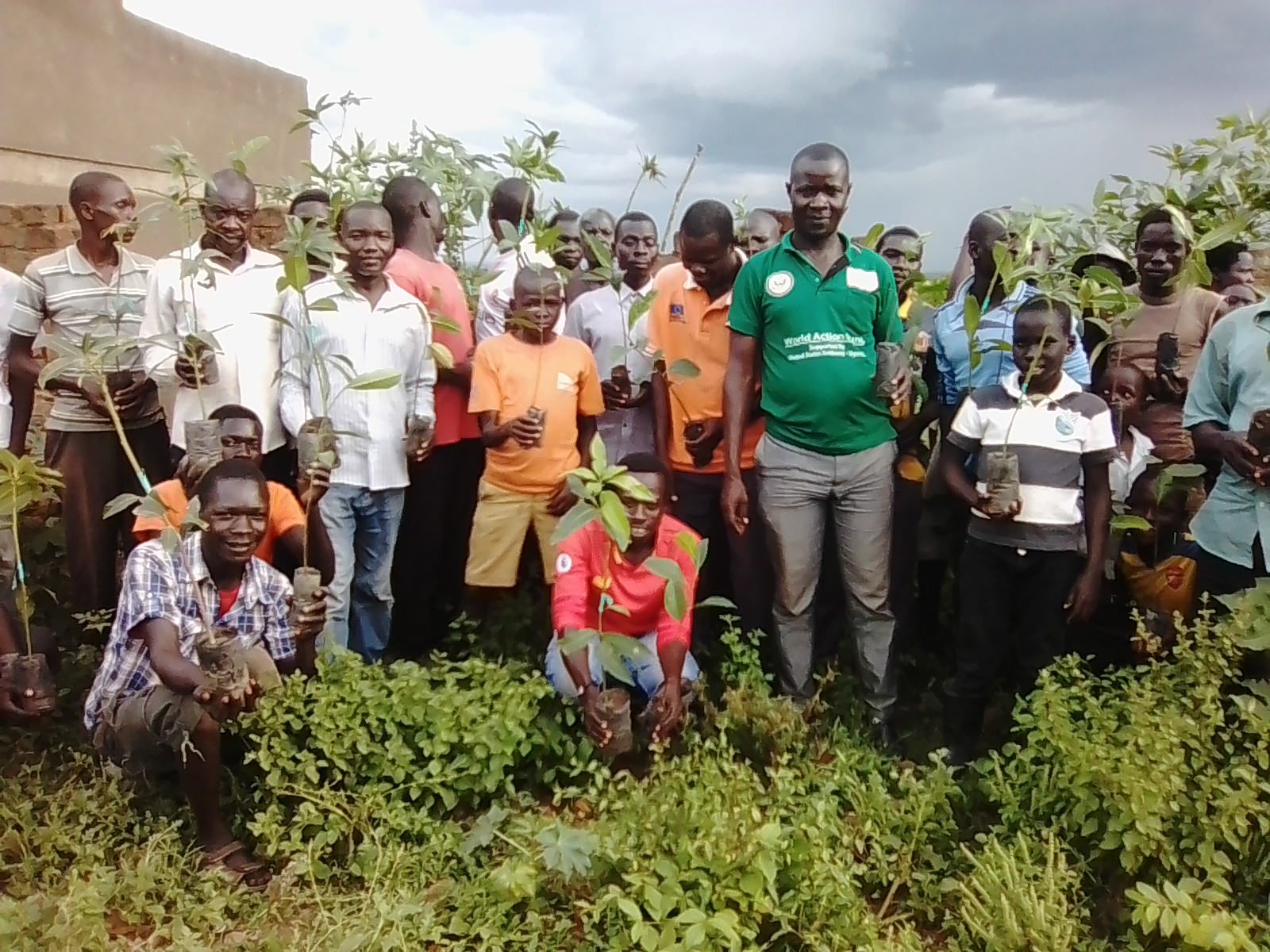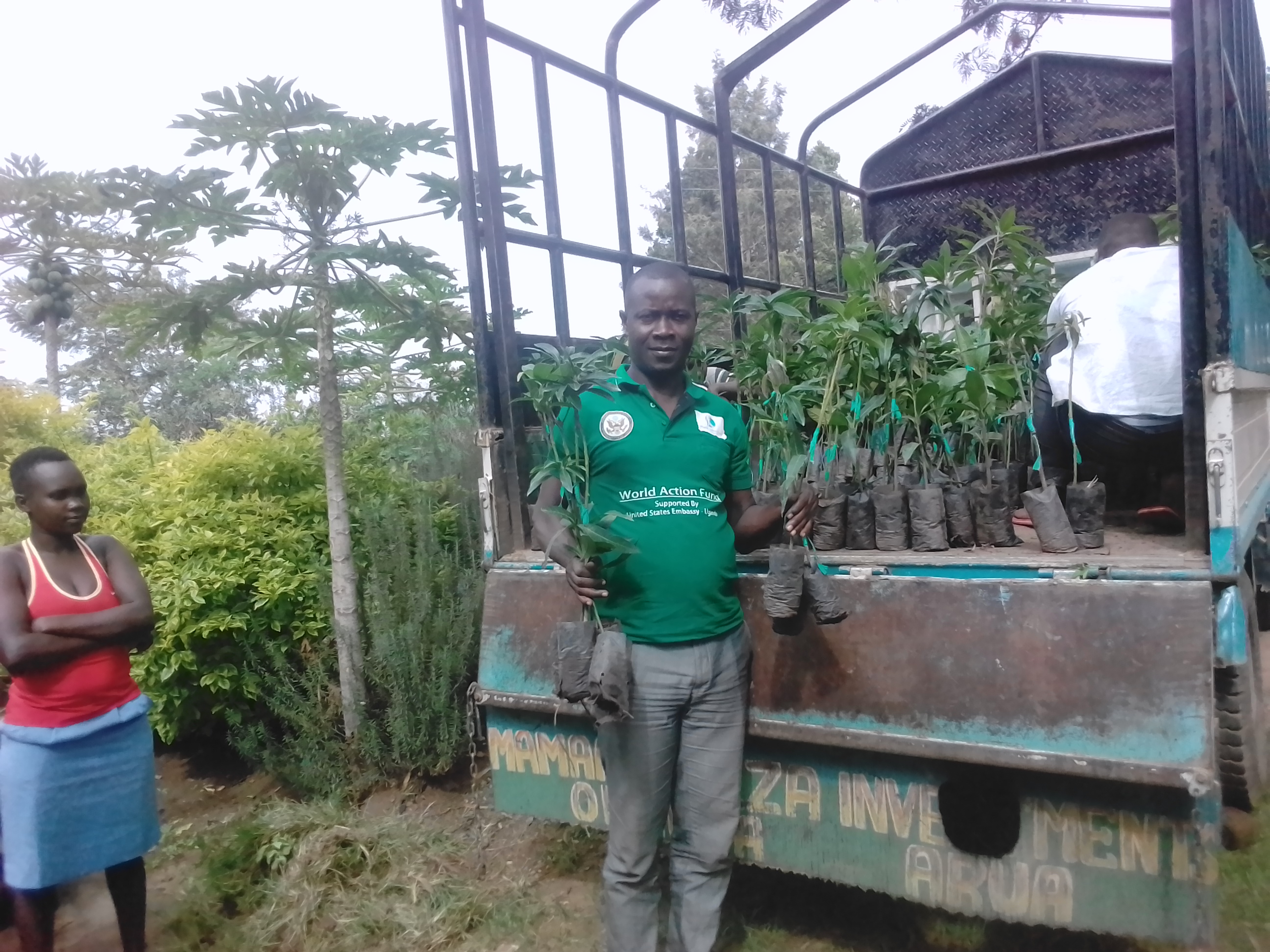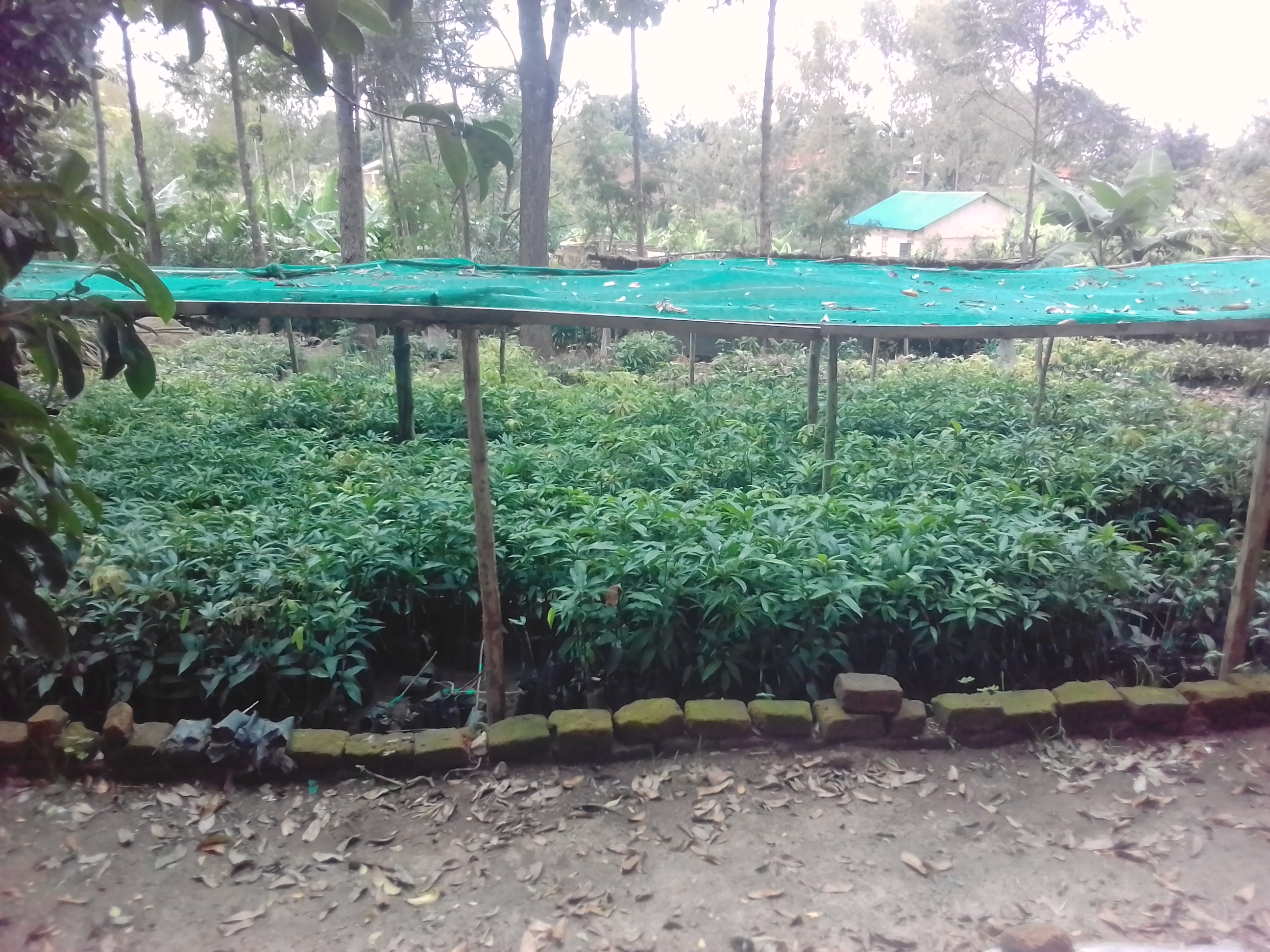Reducing Carbon Emission Through Environmental Conservation and Awareness
Description
The South Sudanese refugees who are currently settleing in savana wood land in West Nile region havve no any other source of wood fuel and construction materials, hence already depleting the already exhausted natural species of forests. The project took 1 year, with livelihood components in energy saving stove making, reusable sanitary pad, business training skills and tree planning (fruit trees and wood trees) 24,000 rees planted along the Imvepi refugee settlement and hosting communities.
To foster the climate change effects that threatens seriously undermine efforts to eliminate poverty and reach the Millennium Development Goals (MDGs), particularly in the least developed countries. At greatest risk are the rural poor in these countries, who depend on the natural environment for their livelihoods. Above and beyond current levels of official development assistance, major new investments and innovative financing mechanisms are needed to help developing countries with their efforts to cope with the impacts of climate change, and create more sustainable, less greenhouse-intensive development paths. Emerging market mechanisms have the potential to augment the financial resources available to developing countries, but thus far the rapidly expanding international market in carbon offsets has focused on relatively few countries, with emission reduction projects that, for the most part, have generated little in the way of broad-based sustainable development or poverty reduction benefits.
•Conduct research, consolidate and report best practices and solutions in policy advocacy, capacity development and knowledge management on issues relevant to REP-PoR (Regional Energy Programme for Poverty Reduction)
•Build a network of institutions to collaborate in sharing information and knowledge products relevant to the practical needs of REP-PoR in promoting the creation of a virtual knowledge network/exchange across the region
•Develop and implement a REP-PoR communications strategy, including co-ordinating programme communication, promotion and outreach activities
•Prepare, edit and co-ordinate the publication and dissemination of REP-PoR publications, outreach materials and press releases
•Work closely with the REP-PoR team in determining the most relevant information resources to be indexed and maintained in web-based workspace
•Work in partnership with Steering Project Team Knowledge Services Team to develop and implement knowledge products and systems to support REP-PoR activities, inconformity with RCB’s knowledge services standards and requirements
•Establish and maintain a Knowledge Platform (Virtual Information Centre) for REP-PoR and the Practice Team
•Contribute to the monitoring and assessment of progress of output activities, and to the preparation and distribution of the required progress reports (quarterly, semi-annual and annual) to the Project Steering Committee and the Steering Project Team Management Board
•Undertake other related tasks as requested by the team manager.
Project component management:
•Prepare the Annual Work Plan and manage the production of the planned deliverables
•Partnership and resource mobilization in support of workplan
•Draft TORs and work specifications for consultancies/subcontracts
•Be responsible for overall project component administration
•Manage and supervise the staff under the project component including two professional staffs, following agreed personnel guidelines, including provision of regular staff work plans and performance appraisals.
Project monitoring, reporting and knowledge management:
•Plan and monitor activities as determined in the Project Monitoring Schedule Plan; and update the plan, as required
•Manage the risks as determined in the Project Risks Log, including the development of contingency plans as necessary
•Participation in development of UNDP’s global and regional policies, including preparation of policy pieces and contributions to research and position papers and other knowledge products;
•Sharing of information and results within Steering Project Team, CSOs and UNDP and relevant knowledge networks and maximising knowledge capture in practice and cross-practice activities;
•Provide substantive support and serve as a resource person on the subject of expertise to UN country offices in the region , member countries and support knowledge networks
•Build and strengthen strategic partnerships with regional agencies, CBOs, NGOs and other development organisations.
•Prepare Lessons-learned Reports
•Prepare any follow-on action, recommendations, reports, as required
1. Institutional capacities enhanced to manage, adapt and monitor climate change, and leverage carbon financing
2. Poor enabled with improved access to ecosystem assets and sustainable and affordable energy services
Expected out comes:
Climate Change:
1. Government partners have awareness, knowledge and ability for climate proofing of development plans and sectoral policies;
2. Regional/national institutions and private sector are able to access investments and financing to address climate change, particularly carbon financing.
Energy:
1. Planners and policymakers in five MDGS countries are able to incorporate strategies on access to energy services for poverty reduction within national development planning and budgeting frameworks, especially in the face of rising oil prices and it’s products.
2. Members of local/community level institutions (local government, CSOs, micro-enterprises and financial institutions) are able to formulate or amend policies/strategies/programmes that can respond to and facilitate access to energy services, using the community-based PPP approaches to promote productive uses of renewable energy, for income generation/poverty reduction.
3. Government partners and regional/national institutions engaged in joint activities that foster regional cooperation in energy security and able to provide due attention to human development issues in regional energy resource pooling and trading initiatives/programmes to promote energy security for the poor.
Ecosystems:
1. Government partners able to integrate ecosystem services into national development plans;
2. Lessons learned, and good practices on poverty-environment nexus, including Gender dimensions, shared across the region;
3. Government partners able to use tools for better coastal planning and management, as well as coordinate policies with other governments and regional institutions to support sustainable coastal ecosystem services in six Tsunami-affected countries
Some governments have taken proactive steps to ‘green’ their national development strategies. However, for the East African region, environment issues still factor largely in the periphery, and governments have not adequately prioritized environment as an essential part to sustainable poverty reduction plans and strategies. The trade-offs between conservation and development are strongly influenced by economic measures and indicators. But the political and economic calculations that underpin much of the development decision making are flawed and incomplete because they omit an important set of costs and services, that is, the values associated with ecosystem goods and services. From an integrated system perspective, much of the current decision-making fails to account beyond “direct†values (such as raw materials used for production, consumption and sale) and include potentially higher “indirect†values “option†values (future possible uses still unknown) and intrinsic “existence†values that are of cultural and intergenerational dimension. The belief that development infrastructure lies at the heart of economic growth and regional integration has been prevalent among national governments and donors. Yet natural infrastructure rarely receives the attention and investment needed. Instead, limited budgets are devoted to somewhat narrowly-conceived conservation projects.
Women are often most adversely impacted as they spend more time collecting wood or clean water due to growing resource scarcity. They also suffer from more restricted access to land and other natural resources. At the same time, the East African region is contributing significantly to the global climate crisis. Climate change impacts will intensify existing vulnerabilities and bring a whole additional set of challenges. It is crucial to climate-proof development plans and sector policies and embed adaptation strategies within poverty reduction strategies. Implementing ecosystem and natural resources management plans to rehabilitate and conserve critical ecosystem services, and promoting alternative livelihoods options can play an important role in reducing vulnerability to climate impacts.
Under this component RCCEEP will leverage the work that has been completed so far under REP-PoR, as described in section 2, to proactively explore opportunities to engage bilateral and multilateral partners in joint activities, consistent with the three key outputs. UNDP core resources through this project will be used to leverage sustainable partnerships, to seed innovative initiatives and to mobilize additional resources and capacity to ensure long-term impact of project interventions. In particular, in efforts to build local institutional capacity and sharing of knowledge, the project will also seek partnerships with the private sector and micro-finance institutions (MFIs) to promote PPP approaches in productive uses of renewable energy. Key institutions like Global Village Energy Partnership (GVEP), International Network on Gender and Sustainable Energy (ENERGIA), Global Network on Energy for Sustainable Development (GNESD) and Liquefied Petroleum Gas (LPG) Challenge, share common interest energy access and energy security. The project will seek to organize a forum for periodic consultations to identify points of convergence to promote regional initiatives.
Ecosystems: The strategy for resource mobilization under component 3 builds on and complements ongoing efforts to secure funding from public and private sources as well as bilateral and multilateral initiatives, including activities carried out by the GEF. Core resources will be used to build partnerships and mobilize resources towards implementing sustainable, pro-poor interventions at the national and regional level.
Climate Change:
Each project that gets approved by MDG carbon/ the CDM board will trigger an investment from a Northern country (either from a private company or a government) in a developing country. The average investment is estimated at USD 2 million. This money would not be invested without our work, hence we can say this investment was leveraged by UNDP Regional Centre in Bangkok (UNDP RCB). But this money will not flow through UNDP accounts, it will be a contract directly between 2 companies/ institutions. Each approved MDG Carbon project will generate a fee for UNDP of USD 285,000 of which USD 71,000 would remain with the Central Bank for services of the regional technical advisors. The balance will go to the COs, UNDP HQ etc. So in terms of fees UNDP will earn 285 k x number of projects of which 71k x number of projects would remain with the Central Bank. Similarly, each project that gets approved by one of the adaptation funds will be a project implemented by UNDP, hence this money will flow through UNDP accounts. The average project size is estimated at USD 2 million. For the purpose of this strategy it is estimated that a 5% fee is being paid (according to the financial model of the Spanish MDG Fund), which would result in fees for UNDP of USD 100k x number of projects of which approx. 33k x number of projects will remain with the RCB for services of the regional technical advisors. The resource mobilization target of USD 1,600,000 can be met by having 4 MDG carbon projects approved (4x285,000=1,140,000) and 5 adaptation projects (5x100,000=500,000).
All countries in Africa are affected by climate change, but the poorest countries are most vulnerable to its adverse impacts. They are the ones who are most exposed to extreme weather events and climate-induced disasters, the least able to recover from losses caused by these events, and the most dependent upon natural resources for economic development. As a result, climate change poses a serious risk for many developing countries to attaining the Millennium Development Goals (MDGs).<br />
It needs collective effort to fight it.
SDGS & Targets
Deliverables & Timeline
Resources mobilized
Partnership Progress
| Name | Description |
|---|---|
| 14.1 | By 2025, prevent and significantly reduce marine pollution of all kinds, in particular from land-based activities, including marine debris and nutrient pollution |
| 14.2 | By 2020, sustainably manage and protect marine and coastal ecosystems to avoid significant adverse impacts, including by strengthening their resilience, and take action for their restoration in order to achieve healthy and productive oceans |
| 14.3 | Minimize and address the impacts of ocean acidification, including through enhanced scientific cooperation at all levels |
| 14.4 | By 2020, effectively regulate harvesting and end overfishing, illegal, unreported and unregulated fishing and destructive fishing practices and implement science-based management plans, in order to restore fish stocks in the shortest time feasible, at least to levels that can produce maximum sustainable yield as determined by their biological characteristics |
| 14.5 | By 2020, conserve at least 10 per cent of coastal and marine areas, consistent with national and international law and based on the best available scientific information |
| 14.6 | By 2020, prohibit certain forms of fisheries subsidies which contribute to overcapacity and overfishing, eliminate subsidies that contribute to illegal, unreported and unregulated fishing and refrain from introducing new such subsidies, recognizing that appropriate and effective special and differential treatment for developing and least developed countries should be an integral part of the World Trade Organization fisheries subsidies negotiation |
| 14.7 | By 2030, increase the economic benefits to Small Island developing States and least developed countries from the sustainable use of marine resources, including through sustainable management of fisheries, aquaculture and tourism |
| 17.14 | Enhance policy coherence for sustainable development |
| 14.a | Increase scientific knowledge, develop research capacity and transfer marine technology, taking into account the Intergovernmental Oceanographic Commission Criteria and Guidelines on the Transfer of Marine Technology, in order to improve ocean health and to enhance the contribution of marine biodiversity to the development of developing countries, in particular small island developing States and least developed countries |
| 14.b | Provide access for small-scale artisanal fishers to marine resources and markets |
| 14.c | Enhance the conservation and sustainable use of oceans and their resources by implementing international law as reflected in United Nations Convention on the Law of the Sea, which provides the legal framework for the conservation and sustainable use of oceans and their resources, as recalled in paragraph 158 of "The future we want" |
Feedback
Action Network


Timeline
Entity
Region
- Africa
Geographical coverage
Photos



Website/More information
Countries
Contact Information
Peter Odama, Executive Director
